The ancient presence of the Jews in the Holy Land is backed up by overwhelming evidence. Here’s just some of the finds.
From the surprising findings of the first Israelite settlers to the Kingdoms of David and Solomon to the destruction of the Second Temple • Against the endless pro-Palestinian denialist propaganda, we present but ten of the most prominent written findings which link the Jewish People to its land
Gideon Weinberger and Boaz Levy
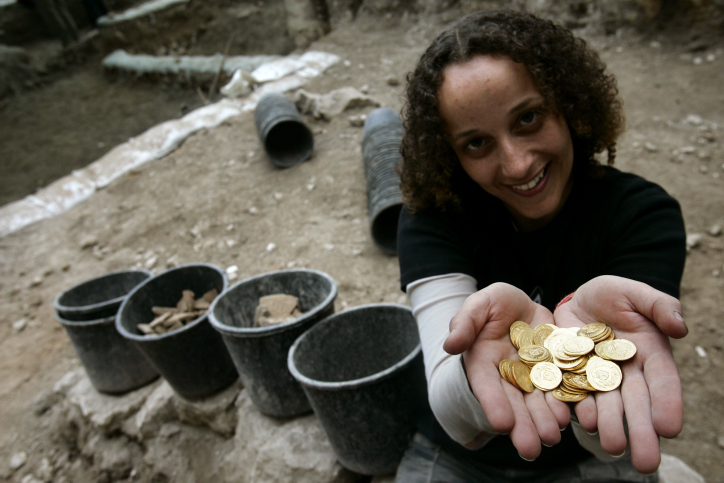
“They argue that 2,000 years ago, they had a Temple here. I challenge this argument.” Thus PA Chairman Abu-Mazen, at the ‘International Conference for the Defense of Jerusalem’ held in Qatar in 2012. Abbas represents a growing trend in the anti-Zionist world of attempting to deny and undermine the connection between the Jewish People and the Land of Israel. Indeed, Abu-Mazen didn’t add anything to that other expert archaeologist Yasser Arafat said when he quipped: “they haven’t found a single stone which would prove the Temple was there.”
But Abu-Mazen and Yasser Arafat aren’t alone: a long list of Arab leaders and politically radical scholars from Israel and Europe, are making the same arguments at an increasing rate. When the lies run round the world, every so often we need to remind people of the obvious.
The first Israelite settlers: Myth or reality?
So what is the historical basis for the Zionist claim to the Land of Israel?
According to the Biblical tradition, after the Exodus from Egypt, the Israelites wandered in the desert for forty years. After a series of conquests on the East Bank of the Jordan River in present-day Jordan, the Israelites led by Joshua crossed the Jordan River opposite Jericho and prepared to conquer the entire land west of the river.
Over the next few centuries, the Israelite tribes took over much of the area, especially the central mountain range (the present day West Bank and the Galilee). Two hundred years after they crossed the Jordan, in the days of Saul, David and Solomon, the conquests were expanded until the kingdom stretched from present-day Eilat to the outskirts of Mesopotamia (present-day Iraq).
Even if one doesn’t accept every detail of the Biblical description, there is no doubt that Israelite tribes did penetrate into the Land of Israel and conquer it. Scholars are split on who exactly these tribes were and how they formed, but all the findings show that they was a fairly homogenous and cohesive group of people, with clear characteristics of a common ethnic-national culture.
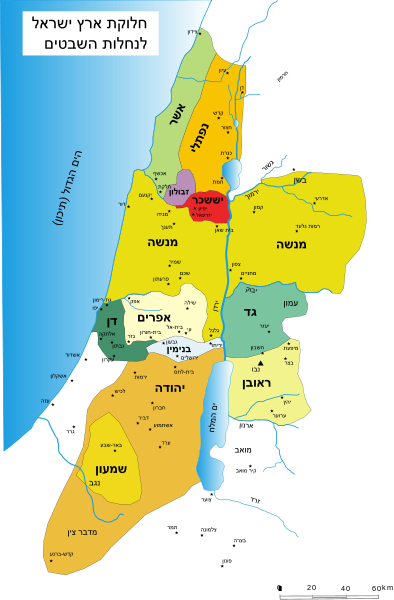
This conclusion was formed after years of intensive digging: in hundreds of sites throughout the Land of Israel, new settlement sites were discovered, all dated to the 13th century – the accepted dating for the period of Israelite settlement and conquest. Some of these settlements were placed in virgin territory and some on the ruins of earlier towns, destroyed during the conquest. The archaeology of settlement in the land of Israel thus largely corroborates the Biblical narrative of a conquering people some 3,200 years ago.
A cohesive group with a common culture
How are we so confident that the findings point to a cohesive ethno-national group different from the previous Canaanite inhabitants? Well, for one thing, all the sites are characterized as Israelite share characteristics which are strikingly different from previous sites but which share certain commonalities: massive and specific use of a type of storage jug (‘collar-rimmed’ jugs), exclusive use of a specific type of construction – ‘four-room houses’ and ‘settlement pits’ – which are not only different in form but also much less refined and more primitive than the settled peoples – as befits nomadic tribes only beginning to settle down.
But that’s not all: particularly prominent is the zoo-archaeological evidence of pig bones (or more accurately lack of evidence). While in sites clearly identified as “non-Israelite” in the Land of Israel and outside of it is a high concentration of pig bones, there are no such bones at Israelite sites. This is very powerful evidence of the entry of a new group with different dietary habits than the entire surrounding areas. Even Prof. Israel Finkelstein, known for disputing the Biblical description of the period of settlement, admitted that:
The prohibition on pig consumption cannot be explained solely by environmental or economic factors. In fact, this may be the only hint we have for a specific and common identity among these village dwellers west of the Jordan; it may be that the first Israelites stopped eating pigs simply because the surrounding peoples – their opponents – ate them. […] When the Jews of today [avoid eating pig], they are continuing the most ancient Israelite custom for which we have archaeological evidence.
The Overwhelming Evidence Doesn’t Lie
Even if we lack written evidence from the settlement period (with the exception of the 13th century BC Merneptah stele which mentions the existence of “Israel”), the further we move along the timeline towards the Monarchical and Second Temple Periods, innumerable amounts of evidence piles up which leave no room for doubt: the People of Israel was in the Land of Israel for more than 3,000 years, eventually conquered much of it, and controlled it for about 1,500 years before they were finally broken and dispersed.
The list of archaeological evidence is never-ending: we will present here only the most prominent, especially those which contain text or explicitly describe matters in writing. All the “mute” archaeological evidence such as the impressive altar exposed on Mt. Ebal from the period of settlement (Zartal), Khirbet Qeyafa (Garfinkel), the ruins of Lachish and Samaria, Gamla, the City of David, Tzipori, the Temple Mount – which prove the Israeli presence but require additional background and geographical comparison to the sources – will be left for another time. We also cannot, within the confines of this article, refer to all the philological evidence which corroborate parts of the Biblical narrative (for instance, the theophoric suffixes to Israelite names such as Berachyahu, Yirmiyahu, Yehezkel, Israel – which distinguish the Israelites from their neighbors; in the Phoenician culture, for instance, the deity was Baal: thus in Phoenician areas the names were Hanibaal, Baalnatan, Yerubaal, in sites identified as such).
The Great Finds
Five Prominent Finds from the Land of Israel
1. The Ketef Hinom Silver Scrolls – in the Ben-Hinom valley in Jerusalem, a large system of some fifteen burial halls dug into the rock were discovered in the 1980s. Although they were largely looted over the years, they nevertheless procured a treasure trove of jewels and other items missed by the grave robbers. Among the items were two items of exceptional importance: a pair of tiny silver scrolls about the size of a cigarette butt containing the most ancient Biblical text found thus far, dated to the 7th century BC or some 2,600 years ago.
The text itself contains the Priests’ blessing contained in the book of Numbers (with a few differences), and its owners probably used them as amulets. The process of deciphering was particularly complex, and even made use of the Israeli police CSI unit.

2. The Dead Sea Scrolls – A Bedouin youth who left his flock to look for a missing goat in the Judean Desert, came upon a dark crevice. He threw a stone in out of curiosity, and was surprised to hear the echo of cracking pottery. The youth went into the dark cave, and the rest, as they say, is history: the discovery of the Dead Sea Scrolls, one of the greatest archaeological findings of the 20th century. Hundreds of scrolls, preserved in ceramic jugs, and dated from the 2nd century BC to the 2nd century AD (some even to the 3rd century BC). They constitute the oldest preserved collection of Biblical books, including every book save Esther. 24 pairs of tefillin were also found in the caves.
Although the scrolls were written on parchment, the unique climate of the Judean Desert allowed their preservation over thousands of years. The content of the scrolls (which include everything from day-to-day affairs to mysticism) has led to a fierce debate between researchers about the identity of the scrolls’ authors – were they Essenes, Pharisees, rebels or even Christians? Among the scrolls was even one engraved on copper and which describes treasure troves of gold hidden in the Jerusalem area.
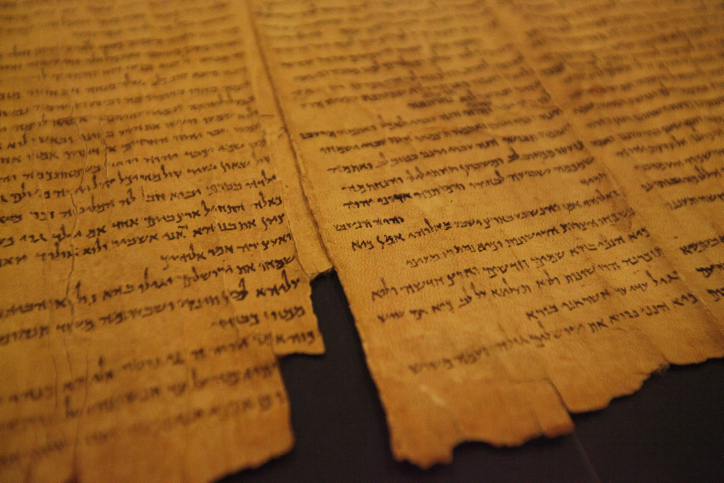
3. The Tel Dan Stele – The Aramean kingdoms north of the Land of Israel, in the area of Syria of today, were the bitterest enemies of the Kingdom of Israel for years. With the exception of the days of David and Solomon and a few other brief respites, Israel was in almost constant conflict with Aram. In the excavations in Tel Dan in the Huleh Valley (northern Israel), a wonderful echo of these wars was found, and more importantly, the most ancient non-Biblical mention of the House of David (if we ignore the Mesha Stele, discussed below).
One of the Kings of Aram, apparently Hazael, placed a large stele describing his military victories in the north of Israel. This monumental stele, dated to the 9th century BC and written clearly on smooth stone, clearly mention both the “King of Israel” and the “House of David” being defeated by Aram.
This finding, clearly attesting to the existence of the Royal House of David, laid to rest minimalist claims that David never even existed. By the way, the stele was placed on the floor of the gateway into the city of Dan, perhaps as a sign of contempt for the Aramean Kingdom.

4. The Siloam Inscription – King Hezekiah, who ruled Judah 2700 years ago, rebelled against Sennacherib, ruler of the Assyrian Empire, and fought against him. According to the Bible he prepared for war against this ancient imperial power in two ways: one was a massive fortification project, strengthening the walls of Jerusalem, and the other digging a half-kilometer tunnel to divert the city’s water source of the Gihon Spring to within those walls. The fortification project is described in the Bible: “You saw that the walls of the City of David were broken through in many places; you stored up water in the Lower Pool. You counted the buildings in Jerusalem and tore down houses to strengthen the wall.” (Isaiah 22:9-10) and indeed the massive wall itself was found after the Six Day War when the Jewish quarter was archaeologically excavated.
But the truly impressive find was the Siloam tunnel – dated to Hezekiah’s time – and finding the ancient sign which describes the project of digging the tunnel. This project is described in general terms in the Bible: “And the rest of the acts of Hezekiah, and all his might, and how he made a pool, and a conduit, and brought water into the city, are they not written in the book of the chronicles of the kings of Judah?” (2 Kings 20:20)
But how was it actually done? Well, over a hundred years ago, a stone sign describing the final stages of the project was found etched in stone on the wall of the tunnel. It turns out from the ancient Hebrew text that two groups dug from opposite directions until they met and connected the two parts of the tunnel (source: K.C. Hanson):
[. . .] the tunneling; and this was how the tunneling was completed: As [the laborers employed] their picks, each crew toward the other, and while there were still three cubits remaining, the voices of the men calling out to each other [could be heard], since it got louder on the right [and lef]t. The day the opening was made, the stonecutters hacked toward each other, pick against pick. And the water flowed from the source to the pool [twel]ve hundred cubits, (despite the fact that) the height of the rock above the stonecutters’ heads was one hundred cubits.
Given the engineering capabilities of the time, the accuracy of the tunnel is particularly impressive.

5. The “Place of Trumpeting” Stone and Second Temple warning sign – We began this article with the denial of the existence of the Jewish Temple, so we will end this section with two findings from the Second Temple Period dated to the first century BC. The first is a large, sculpted cornerstone found south of the Western Wall, with the Hebrew inscription “to the Place of Trumpeting”. The stone fell from the top of the Temple Mount, probably while the Romans were destroying the city. What is this place of trumpeting? A designated corner of the Mount of the House of God (i.e., the Temple), from which priests would blow a trumpet to announce the coming of the Sabbath (much like a siren does today in Jerusalem) and at other times.
Another Second Temple finding is a large stone with a Greek inscription, which warns non-Jews from entering the Temple: “No Gentile may enter beyond the dividing wall into the court around the Holy Place; whoever is caught will be to blame for his subsequent death.” This sign was one of many (one of which is in the Istanbul museum) which set the boundary to the Temple beyond which non-Jews may not pass. The Jewish historian also described these signs: “…and on this barrier were at equal distances pillars which declared the laws of purity, these in Greek script and these in Greek and those in Latin, stating that a non-Jew may not come to the [Temple]”. He even described the reaction of Titus, destroyer of the Temple, to these signs:
And Titus was greatly angered by this […] did you not place on the [dividing] grate those pillars on which were inscribed in Greek and our language (Latin), that no foreigner should dare cross this barrier?

5 Major Findings outside the Land of Israel (and then some)
1. The Mesha Stele – In the 9th century BC, some 2900 year ago, the House of Omri ruled the Kingdom of Israel. Omri and his son Ahab were among the best and strongest kings of that Kingdom, despite the Bible’s reproach of their religious and moral failings. They forged alliances with the Kingdom of Judah and other Kingdoms in the region. For instance, they allied with Aram to fight the imperial power Assyria to a standstill at the Battle of Qarqar and subjugated the Kingdom of Moab to the east. However, after the death of Ahab, Moab rebelled against Israel. The Bible describes it thusly: “But it came to pass, when Ahab was dead, that the king of Moab rebelled against the king of Israel.” (2 Kings 3:5)
Over a hundred years ago, an impressive stone stele was discovered east of the Jordan which tells the story of that subjugation and subsequent rebellion from the point of view of the Moabite King Mesha (hence the name). In the stone Moabite inscription, the name Israel is mentioned many times; Omri himself is mentioned by name: “Omri King of Israel, and he oppressed Moab for many years”. In the opinion of some scholars, the stele also contains the oldest mention of Beit David: “And I captured from there the Arel of Davida”. The tribe of Gad is also explicitly mentioned: “And the people of Gad settled in the land of Atarot of old” recalling the Biblical verse “and the children of Gad built Divon and Atarot.” (Num. 32:34)
The house of Omri and the Kingdom of Israel are not some Biblical fantasy – they have outside confirmation from their enemy.
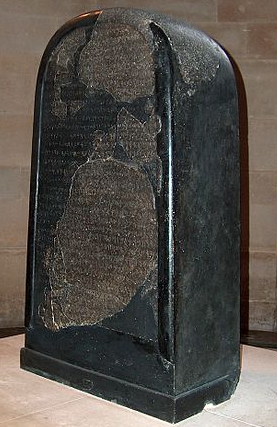
2. The Black Obelisk and the Kurkh Monoliths – The House of Omri was famous throughout the region; they weren’t mentioned only in the Mesha Stele, but also in one of the Kurkh monoliths from the 9th century BC. This impressive stone monument describes the Battle of Qarqar between the King of Assyria (Shalmaneser III) and an alliance of southern kings headed by Ahab, King of Israel. According to scholars, Ahab is described in the monolith as the strongest king in the alliance: “2,000 chariots, 10,000 foot of Ahab the Israelite […] I fought them with the exalted power that Assyria my master granted me.”
The Black Obelisk – a 2800 year old pillar of black basalt stone describing Assyrian battles including Qarqar – also mentions the House of Omri, this time Yoram son of Ahab. The same obelisk features (according to the commonly accepted identification) Yehu King of Israel, who destroyed the House of Ahab and killed the last of its line – the self-same Yoram. The pillar describes the submission of Yehu before Shalmaneser both in writing and pictoral representation.


3. Sennacherib’s Prism – Now we return to Hezekiah and Sennacherib – this time from the Assyrian side. Sennacherib was crowned King of the Assyrian superpower (area of present day Iraq and southern Turkey) 2700 years ago. A number of years into his reign, he went on campaign in the Land of Israel (the same one Hezekiah prepared for with fortifications and by digging the tunnel). After the campaign, Sennacherib’s scribes wrote the story of the war on large prism-like stone pillars, a story that largely matches the Biblical description.
Thus, the Book of Kings states “and in the fourteenth year of King Hezekiah, Sennacherib king of Assyria came up against all the fortified cities of Judah and captured them.” (2 Kings 18:13) and in the Sennacherib prism “and as for Hezekiah the Judaite who did not surrender to my yoke: 46 fortified cities, and the small towns which were numerous in the region […] I besieged them and took them”; The Bible describes the siege of Jerusalem “Then the king of Assyria sent […] a great army against Jerusalem, to King Hezekiah, and they went up and came to Jerusalem.” (2 Kings 18:17), and thus in the Sennacherib prism “like a bird in a cage I sealed him in Jerusalem, his royal city.”
Thus, King Hezekiah, Jerusalem, and the fortified cities of Judah are all explicitly mentioned in an ancient Assyrian source. Another interesting ceramic in this same matter was found in Tel Azeka in Judea.
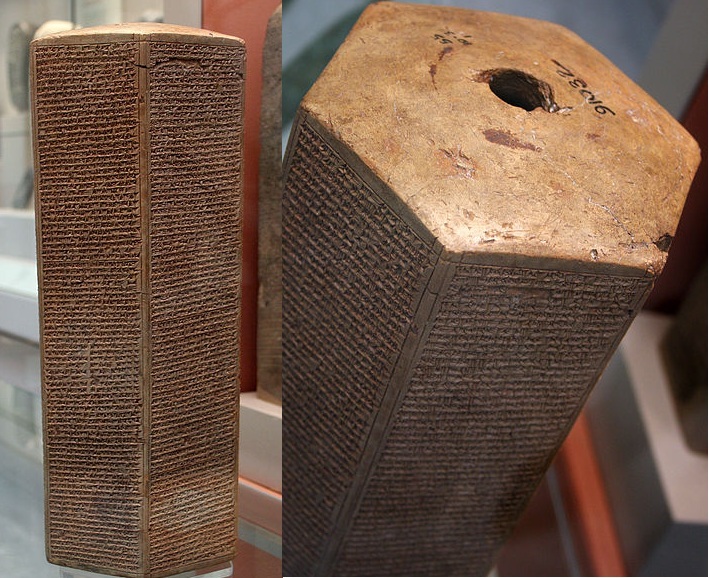
4. The Chronicle of Nebuchadnezzar and the Jehoiachin documents – According to scholarship, the First Temple stood from the 10th to 6th centuries BC. Around 586 BC, Nebuchadnezzar, King of Babylon attacked Jerusalem, destroyed the temple and exiled many of its inhabitants, as the Bible describes: “On the seventh day of the fifth month of the nineteenth year of King Nebuchadnezzar of Babylonia, Nebuzaradan, adviser to the king and commander of his army, entered Jerusalem. He burned down the Temple, the palace, and the houses of all the important people in Jerusalem, and his soldiers tore down the city walls” (2 Kings 25:8-10). The campaign prior to this destruction, in which Judean King Jehoiachin was taken hostage and another appointed in his place (2 Kings 24:8-17), is described in a Babylonian ceramic inscription discovered a century ago: “on the seventh year in the month of Kislev, the King of Akkad (Babylon) raised his army […] he camped [against] the city of Judah […] conquered the city and captured its king. He appointed there a king after his own heart. He received her rich tribute and moved it to Babylon.”
Another rare find which continues this story are four Babylonian administrative documents dated to 592 BC, which describe the conditions of Jehoiachin’s captivity, and the food he received from the Babylonians. In these documents, he is specifically referred to as “the King of Judah”: “10 (sila of oil) to the king of Judah, Yaukin; 2 1/2 sila (oil) to the offspring of Judah’s king; 4 sila to eight men from Judea.”
This also confirms the Biblical description:
And it came to pass in the seven and thirtieth year of the captivity of Jehoiachin king of Judah, in the twelfth month, on the seven and twentieth day of the month, that Evilmerodach king of Babylon, in the year that he began to reign, lifted up the head of Jehoiachin king of Judah out of prison. And he spoke kindly to him and set his throne above the throne of the kings who were with him in Babylon, and changed his prison garments. And he ate bread continually before him all the days of his life; and his allowance was a continual allowance given him from the king, a daily rate for every day, all the days of his life. (2 Kings 25: 27-30)
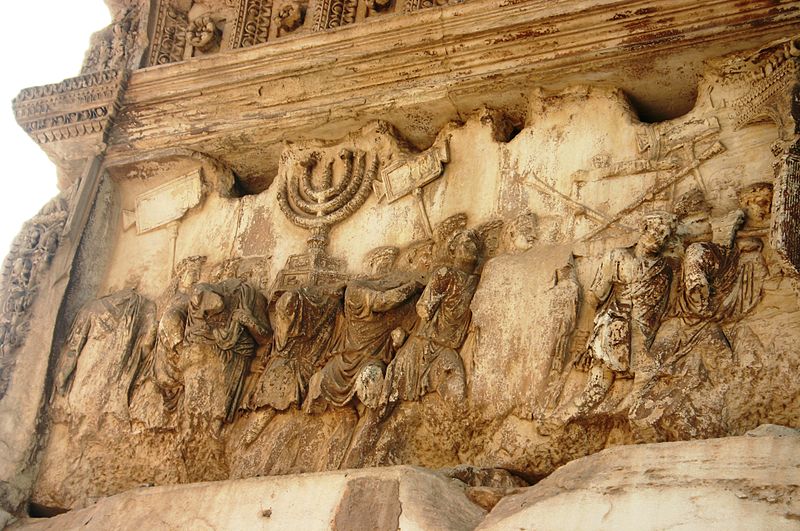
5. The Arch of Titus – If we dealt until now with a few findings related to First Temple Jewish Kingdoms, when we jump to the Second Temple period (6th century BC – 1st century AD) and the wars with Greece and Rome, we’re already dealing with literally thousands of finds. One of the most famous is the 2,000 year old Arch of Titus, which describes the victory of Titus, son of the Ceasar Vespasian and his heir, including the destruction of the Temple at the height of the Jewish rebellion against the Romans (the first of three, the last of which was the Bar Kokhba revolt).
The sculpted Arch portrays a procession of Jewish exiles carrying the relics from the Temple, including the famous golden Menorah or lampstand. Titus and his father did not suffice with the victory arch, but also minted many coins after the victory with the Latin phrase IVDEA CAPTA – Judah has been captured by the might of Rome.
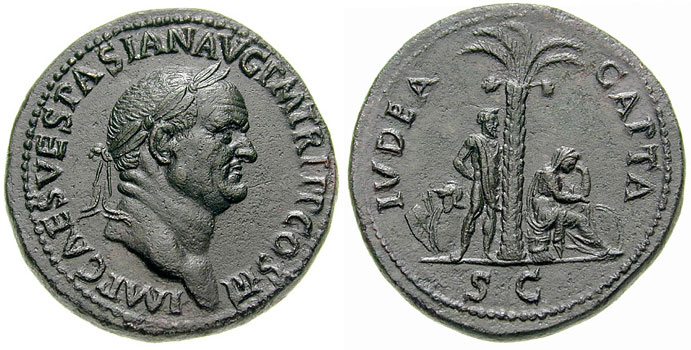
This is all but a small sampling of the many finds which confirm the Jewish ties to the land. We finish with a quote from the Koran, in which Mohammad himself recognizes that which his followers now seek to deny:
And when Musa said to his people: O my people! Remember the favor of Allah upon you when He raised prophets among you and made you kings and gave you what He had not given to any other among the nations. O my people! Enter the holy land which Allah hath assigned unto you, and turn not back ignominiously, for then will ye be overthrown, to your own ruin.” (Koran 5:20-21)
English translation by Avi Woolf.
To receive updates on new articles in English, join Mida on Facebook or Twitter or join our mailing list.



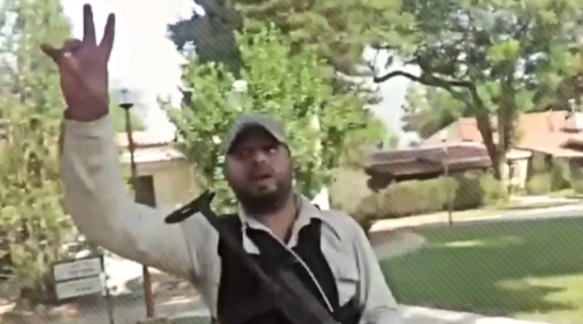
great! But why use an image of a presumably Jewish woman…holding a stack of coins?…
כתבה מעניינת ונכונה, ובאמת טוב מידי פעם לזכור את הידוע, (כפי שמזכיר הכתב).
When the lies run round the world, every so often we need to remind people of the obvious. (בהקשר לתגובה הקודמת)
Did the Exodus really happen, was there a King David Where was the Temple etc. Yet one rarely hears challenges to Jesus’ wine and loaves. Where is the contemporaneous writings or proof of Jesus? Does anyone question mohameds’ flying horse ride to the far mosque? Where was the far mosque? It was NOT in Jerusalem which was still under Christian control; and a basilica was on the Temple Mount.
Shocking that in this very, very interesting article the writers use BC and AD, which are Christian time designsations! Scholarly, and increasingly popular usage is CD = Common Era and BCE = Before the common Era.
Please, folks, do not tarnish your wonderful scholarship by using “Christ” time designations!